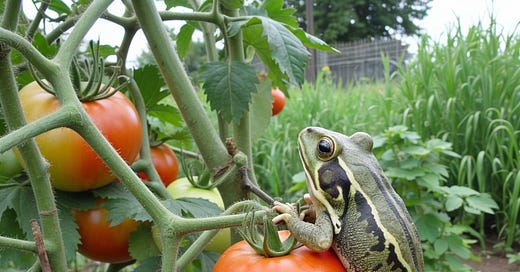Why a Simple Pause Protects What Matters Most
What Nature, Frogs, and Tomatoes Teach Us About Timing and Clarity
There is a quiet beauty in the pause. Nature reminds us that not all action is forward motion, and not every silence is empty. A seed rests in the soil, not rushing to sprout at the first drop of rain, but waiting—for warmth, for light, for the balance that signals the moment is right. In this pause, there is both patience and purpose, a stillness that protects and prepares.
In life, unlike nature, we often fail to embrace the pause. In the heat of anger or the rush of frustration, we leap—too quick to speak, too quick to act, too quick to wound. Words, sharp and hurried, can sever the very bonds we hold most dear. Literature captures these moments of rashness with clarity, offering lessons we often learn too late. In *King Lear*, for instance, the aging monarch lashes out at his daughter Cordelia when she refuses to flatter him. In his anger, Lear casts her aside, severing their bond and setting in motion a series of events that lead to his undoing. His story is one of regret, a reminder that the heat of a moment can burn far beyond its passing.
In *Tess of the d’Urbervilles*, Tess struggles under the weight of a secret—her violation by Alec d’Urberville and the child that followed. When she finally tells Angel Clare, the man she loves, he reacts swiftly and harshly. There is no moment to listen, no space for reflection. His judgment is immediate, and the bond between them shatters. The pain that follows for both Tess and Angel might have been avoided if there had been a pause—a chance to understand rather than condemn. This story reminds us that a pause is not just a delay; it’s an opportunity to see more clearly, to find compassion where reaction might sow regret.
Nature offers its own wisdom in this regard. Seeds, like desert wildflowers, lie dormant for years, wrapped in stillness, waiting for the precise moment when life can take hold. A premature sprout, tempted by false warmth, would wither before its time. Timing, nature whispers, is everything.
Consider the quiet resilience of tomatoes and peppers during drought. When water is scarce, they release abscisic acid, a stress hormone that signals them to close their stomata, conserving moisture and halting growth. This pause is not defeat; it is survival. When the rains return, their vigor does too, stronger for the delay. And then there is the Australian water-holding frog, which burrows underground and enters a state of suspended life, waiting—motionless yet prepared—for the return of rain. These pauses are not passive. They are deliberate acts of preservation, of trust in what will come.
The pause is as much a part of life as the bloom. It allows space for repair, for growth, for understanding. Like the ocean after a storm, which settles into stillness and reflects the sky, the pause offers us a chance to regain clarity and purpose.
When we pause, we choose to listen rather than react, to trust rather than force. It is a quiet rebellion against the urgency of the world, a refusal to be hurried past what truly matters. The pause shapes us, just as it shapes the natural world. It teaches us that beauty is not simply in what grows, but in the stillness that makes growth possible.
As the year comes to its close, perhaps it is time to welcome the pause. To find meaning in the quiet spaces, the moments of stillness between what has been and what is to come. And when the first colors of spring appear, they will be brighter for the time we spent waiting, for the strength we found in the pause.





Thank you for this inspiring post, I'm so impressed with your writing...it flow beautifully with meaning that go straight to my heart. Can't wait for the next one. Thanks again and Happy New Year.
Wonderful insights, beautifully written. Thank you!!